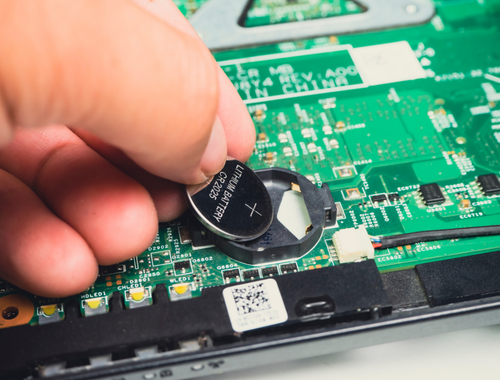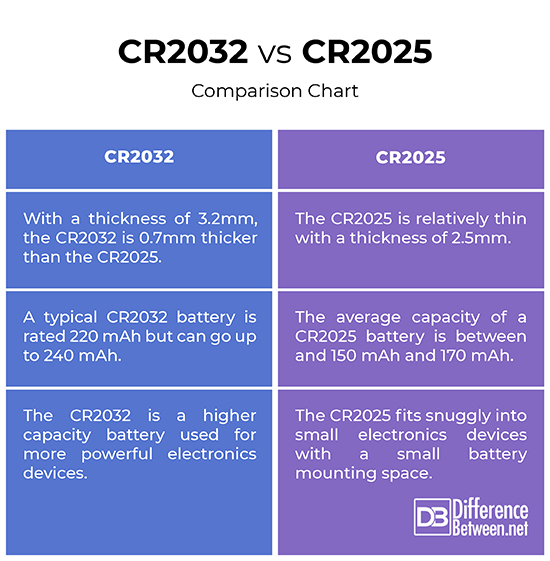Difference Between CR2032 and CR2025
Both are common types of micro batteries. These are the tiniest but high-density batteries with a wide working temperature range. These are small enough to be directly integrated into electronic circuits. A glance at them and you cannot even tell the difference between the two because the two batteries look exactly the same – rounded shape and shiny silver color. The only thing that helps you tell the difference is the notation on the batteries. Both are 3V button cells and supposedly interchangeable, which creates a lot of confusion. We break down the differences between the two batteries.

What is CR2032?
The CR2032 is a non-rechargeable lithium-based battery where the “CR” indicates that it is a lithium battery with manganese dioxide as its positive electrode and lithium as its negative electrode. It is a miniature button or coin battery with a thickness of 3.2mm. It has a voltage of 3 volts and a capacity of up to 240 mAh. This type of battery is commonly used in small electronics such as PDAs, smart watches, computer motherboards, car keys, laser pens, and medical devices such as clinical thermometers. Compared to normal cells, these batteries produce more efficient and stable power. The number 20 suggests that the cell has a diameter of 20 mm and the last two digits indicate the thickness.

What is CR2025?
The CR2025 is yet another common type of lithium-based button cell with almost the same characteristics as the CR2032. It is also a non-rechargeable lithium coin battery with a cylindrical shape and typically 5 to 25 mm in diameter. It is the same 20mm diameter like the CR2032 which the first two digits so suggest. The only difference is the thickness. The last two digits suggest the cell has a thickness of 2.5mm. It also has a voltage of 3 volts with a capacity of up to 170 mAh, depending on manufacturer’s specifications. Like CR2032, it is ideal for portable equipment that requires high energy, such as power tools, toys, cell phones, laptops, wireless peripherals, and more. Being less thick, it slides into battery ports easily.
Difference between CR2032 and CR2025
Thickness of CR2032 and CR2025
– Both CR2025 and CR2032 are lithium based, round shaped non-rechargeable batteries with almost the same characteristics and the same 20mm diameter, which the first two digits so clearly suggest. It’s the last two digits that set the two apart.
The CR2032 has a thickness of 3.2mm whereas the CR2025 is relatively thin with a thickness of 2.5mm. So, the CR2032 is 0.7mm thicker than the CR2025. Besides that, both are 3V batteries.
Capacity of CR2032 vs. CR2025
– Battery capacity is the measure of the charge stored by the battery and is most measured in amp hours (Ah) or milliamp hours (mAh). Battery life is directly related to the battery capacity and is calculated by dividing the battery capacity by the average current required.
A typical CR2032 battery is rated 220 mAh but can go up to 240 mAh. The CR2025, on the other hand, is a smaller capacity battery with the average capacity between and 150 mAh and 170 mAh. More capacity means more power for your device.
Durability of CR2032 vs. CR2025
– A higher capacity battery means a higher mAh rating and higher mAh means longer battery life. For example, a battery with a capacity rating of 100 mAh could deliver a current of 100 mill amperes for one hour.
So, a higher mAH rating means the same battery will last longer. That being said, the CR2032 battery is rated 240 mAh whereas the CR2025 is rated 170 mAh, meaning the CR2032 batteries will run longer and hence more durable.
Uses of CR2032 vs. CR2025
– Both are 3V lithium button cells used in a wide range of portable electronics devices such as wrist watches, calculators, toys, computer motherboards, LED lights, PDAs, car keys, stop watches, medical devices, and more. The CR2025 battery being small is used to power small electronics devices such as laser pens, fitness appliances, clinical thermometers, pocket calculators, toys, and so much more.
CR2032 vs. CR2025: Comparison Chart

Summary of CR2032 vs. CR2025
In a nutshell, both CR2032 and CR2025 are non-rechargeable lithium-based batteries with 20 mm diameter, and both look very identical from the outside. It’s the notation on the battery that sets the two apart. The 32 in CR2032 says the battery is 3.2mm thick whereas the 25 in CR2025 represents 2.5mm thickness. In addition, a typical CR2032 battery is rated 220 mAh whereas the CRC2025 has the average capacity between and 150 mAh and 170 mAh. Besides that, both are versatile and can be used for a wide range of portable electronics devices.
FAQ
Can I replace a CR2032 CMOS battery with a CR2025?
The CR2025 battery is a smaller capacity lithium-based cell that is like a smaller version of the high capacity CR2032 battery. But the CR2025 does not last as long as the CR2032 owing to its lower capacity range. But it works just as well in most applications.
Is CR2025 the same as CR2032?
The CR2032 is generally thicker with a thickness of 3.2mm whereas the CR2025 is relatively thin with a thickness of 2.5mm. Also, a typical CR2032 battery is rated 220 mAh whereas the CRC2025 has the average capacity between and 150 mAh and 170 mAh.
What battery can replace a 2032?
Some other equivalents of CR2032 batteries are CR2025, CR2016, CR1632, CR1216, and more.
What’s the difference between CR2032 and CR2016?
Both cells are 20mm in diameter which the first two digits in their notation clearly suggest. The CR2032 cell is thicker with 3.2mm thickness whereas the CR2016 is almost half as thick as the former. The CR2032 roughly is twice the capacity of the CR2016.
- Difference Between Caucus and Primary - June 18, 2024
- Difference Between PPO and POS - May 30, 2024
- Difference Between RFID and NFC - May 28, 2024
Search DifferenceBetween.net :
References :
[0]Pistoia, Gianfranco. Batteries for Portable Devices. Amsterdam, Netherlands: Elsevier, 2005. Print
[1]Pistoia, Gianfranco. Batteries for Portable Devices. Amsterdam, Netherlands: Elsevier, 2005. Print
[2]O’Shea, Audrey. A Geek Girl's Guide to Electronics and the Internet of Things. New Jersey, United States: John Wiley & Sons, 2020. Print
[3]Torabi, Farschad and Pouria Ahmadi. Simulation of Battery Systems: Fundamentals and Applications. Massachusetts, United States: Academic Press, 2019. Print
